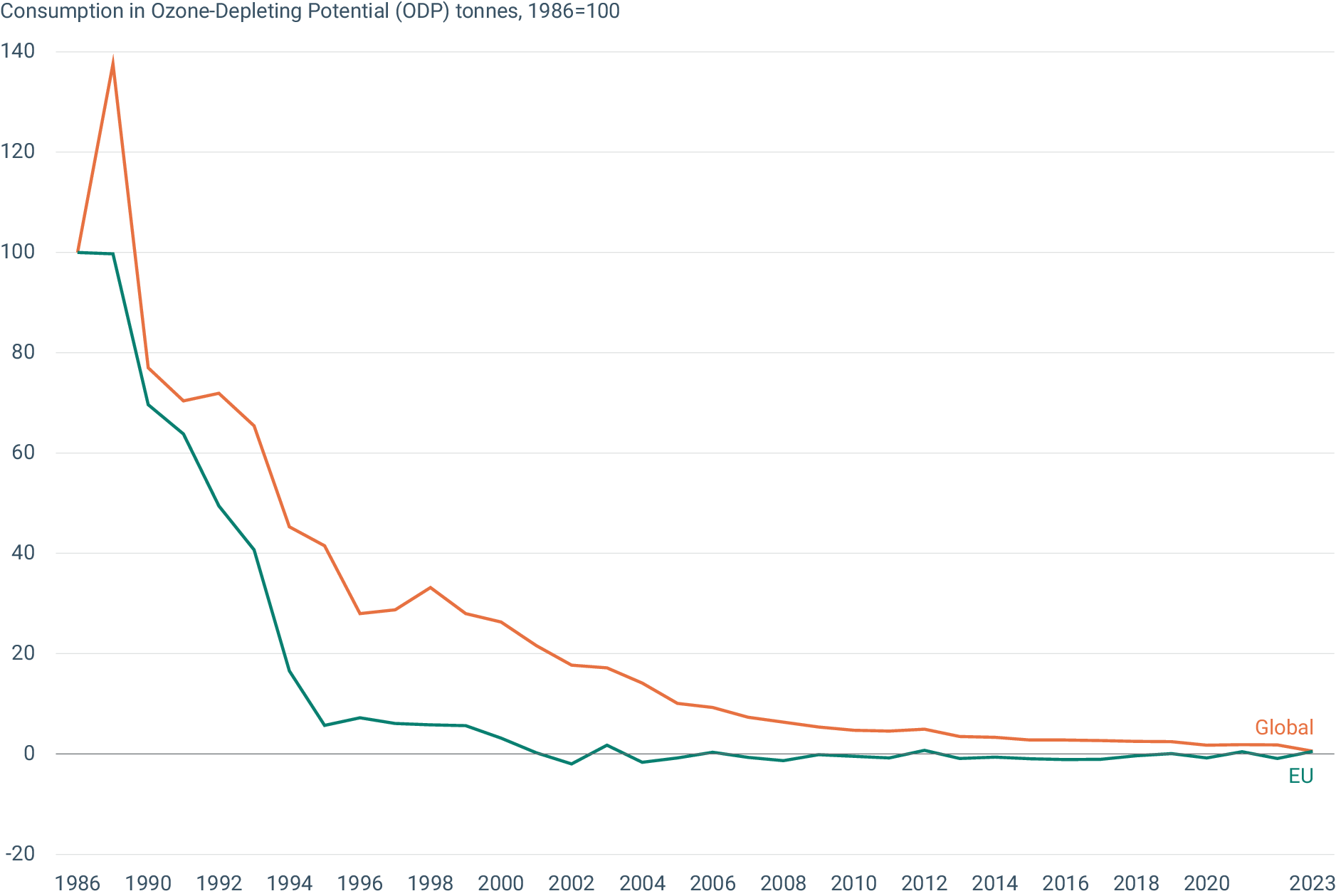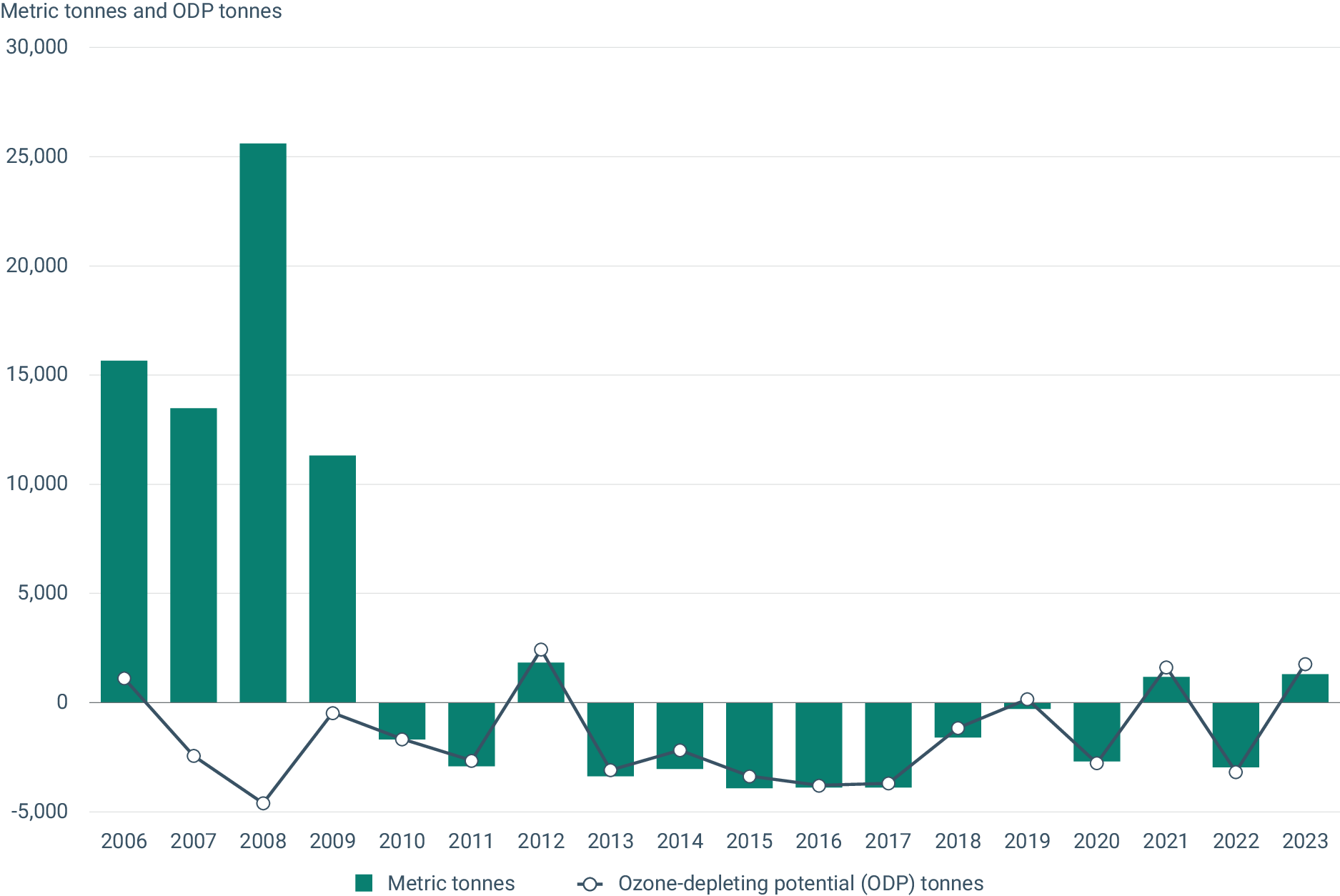Global achievements under the Montreal Protocol
The Montreal Protocol is considered one of the most successful examples of international cooperation on environmental issues. Thanks to the Protocol, the ozone layer is expected to recover to 1980 values (i.e., before the so-called “ozone hole” appeared) by around 2066 over the Antarctic, by 2045 over the Arctic, and by 2040 for the rest of the world.Without the Protocol, atmospheric levels of ozone depleting substances could have increased tenfold by 2050, with devastating consequences for the ozone layer and consequently for our planet and our society.
Consumption of controlled ozone-depleting substances
Beyond protecting the ozone layer, the Protocol is also contributing to the fight against climate change as most ozone-depleting substances (ODS) are also powerful greenhouse gases (GHG). Recent modelling studies estimate that the Montreal Protocol will likely avoid about 0.5–1 degree Celsius of global surface warming by the mid-21st century compared to a scenario with uncontrolled ODS emissions. In addition, a 2016 agreement to phase-down hydrofluorocarbons (HFCs) under the Protocol (Kigali Amendment) is expected to prevent an additional temperature increase of up to 0.5 degrees by 2100.
Participating countries are required to phase out their production and consumption of ODS covered by the Montreal Protocol. ODS are characterised by their Ozone Depleting Potential (ODP), which expresses the relative negative impact on ozone of a certain substance compared to a similar mass of the chemical CFC-11. As an example, CFC-11 is assigned a value of ODP=1, whilst halon-1301has a value of ODP=10, which makes halon-1301 ten times more dangerous for the ozone layer than CFC-11. Consumption and production in the Protocol are measured as tonnes ODP (ODP-t).
For all details on how to calculate ODS consumption, please consult the dedicated page on the UN website. To express the climate impact of ODS the metric GWP (Global Warming Potential) is assigned to each substance, which allows to calculate CO2 equivalents for a given quantity of that substance.
The EU has eliminated all consumption of ODS covered under the Montreal Protocol that do not profit from an exemption, as illustrated in the figure below.

The consumption metric shown aggregates data reported under the Montreal Protocol, calculated based on the balance of production, imports, exports, and destruction. When the combined total of exports and destruction exceeds production and imports, a negative consumption metric, for instance, for the EU in 2022, is recorded. This fluctuation underscores the impact of rigorous regulatory actions on ODS reduction.
Support for developing countries
The Multilateral Fund (MLF) provides financial and technical assistance to developing countries – the so-called Article 5 countries – to help them transition to ODS-free technologies. Created in the 1990s under the Montreal Protocol, the MLF is funded by developed countries, including EU Member States which contribute roughly 50% of the funds.
Thanks to the Fund, Article 5 countries have phased out the consumption of over 756,000 metric tonnes of baseline ODS – the equivalent of 2.2 billion tonnes of CO2 – between 1991 and 2021. For comparison, the total GHG emissions in the EU in 2022 were 3.6 billion tonnes of CO2. The MLF also supports developing country’s management plans to reduce hydrofluorocarbons (HFCs) with high global warming potential (GWP), as established under the Kigali Amendment to the Montreal Protocol in 2016.
Key achievements in the EU
The EU has gone above and beyond its obligations under the Montreal Protocol by adopting:
- A faster phase-out schedule, e.g. phasing out hydrochlorofluorocarbons (HCFCs) in the EU Member States already in 2010 – a decade before it was required in 2020
- A broader list of controlled substances
- Stricter regulations on both bulk substances and those found in products and equipment.
- Promoting the development of innovative technologies to replace ODS, such as alternatives to methyl bromide for fumigation
- Strict rules on the containment of ODS in products and equipment and end-of-life
- Supporting international initiatives to reach ODS phase-out targets
- Combating illegal trade – for these efforts, the European Commission and some EU Member States received the Ozone Protection Award for Customs and Enforcement Officers from the United Nations Environment Programme several times in recent years.
Overall, the EU’s ambitious ODS rules have achieved fast emission reductions, with ODS emissions declining by 98% since 1989 – a significant contribution to protecting the ozone layer and addressing climate change.
The new Regulation on ODS is expected to further prevent up to 32,000 tonnes of Ozone-depleting Potential (ODPt) and 180 million tonnes of CO2 equivalent emissions by 2050. Although ODS emissions are not counted directly under the EU climate targets, the updated EU ODS Regulation will contribute to the EU’s 2050 climate neutrality goal by preserving the ozone layer and curbing the use of powerful greenhouse gases. on ODS is expected to further prevent up to 32,000 tonnes of Ozone Depleting Potential (ODPt) or 180 million tonnes of CO2 equivalent emissions by 2050. Although ODS emissions are not counted directly under the EU climate targets, the updated EU ODS Regulation will contribute to fighting climate change by curbing the use of powerful greenhouse gases.
For more detailed information on ODS in the EU, please consult the annual overview of ODS reported data produced by the European Environmental Agency.

In 2023, EU consumption of controlled ozone-depleting substances amounted to 1,306 metric tonnes, up from -2,954 metric tonnes in 2022. Positive consumption in metric tonnes in 2023 is the result of significant stocking of quantities for ‘Feedstock outside the EU’ which were not reflected in total exports. The consumption of controlled substances, when expressed in metric tonnes, was largely driven by consumption of CTC, which is a chemical used as a raw material for manufacture of other chemicals and products. Expressed in ODP tonnes, consumption in 2023 amounted to 1,778 ODP tonnes, up from -3,165 ODP tonnes in 2022.
